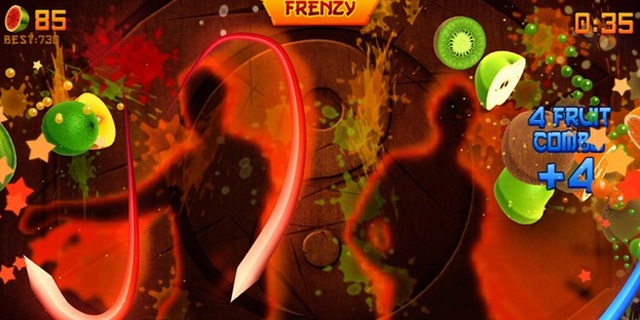
Fruit Ninja, the fruit-slicing game from Halfbrick Studios, has been available for most mobile platforms before now hitting the Kinect. With more than 20 million downloads, it’s clear that the simple-yet-addictive gameplay is a perfect fit for the touch screen smartphones of today, but how well does this game transition over to a motion-sensing console experience?
Like the mobile version of the game, Fruit Ninja Kinect is based around the idea of slicing fruit with a blade. Classic, Zen, and Arcade modes are included and function largely like they do on your mobile device. In Classic, you earn points slicing fruit for as long as possible. The game ends when you slice a bomb or after you miss three fruit. Zen is a 90 second game without any bombs, where you attempt to score as many points as possible. Arcade gives you a minute to slice as many fruit as possible, with bombs deducting 10 points. The Kinect version of the game also features a Party Mode which is essentially either head-to-head or co-op play.
The big challenge for a game transitioning from touch screen to Kinect is the idea of tracking user movement while also letting the player know where they are in relation to the digital objects. Fruit Ninja Kinect does this beautifully, with a silhouette of each player appearing in the background with hand, and foot, motions triggering the blade slices. What doesn’t work as well as it should is actually triggering a slice. Occasionally a deliberate motion wouldn’t register at all, and other very minute movements would register and usually make contact with a bomb. This gets very frustrating. Two-player gameplay is also plagued by players slicing right into each other, resulting in bruised arms. Navigating menus results in the same level of frustration, as the Kinect sensor is reading the wrong hand or not interpreting a motion as a slice when it should.
As a whole, Fruit Ninja Kinect is a real blast to play in short bursts. As an adult, the idea of flailing around swiping at fruit got exhausting and un-enjoyable after a few rounds. My kids, on the other hand, can sit there for an hour slicing and dicing virtual fruit. Drawbacks aside, Halfbrick set the bar very high for Kinect ports and came up with a simple-but-ingenious way to handle the user interaction.



















